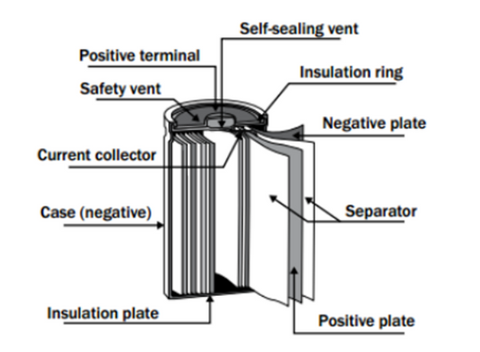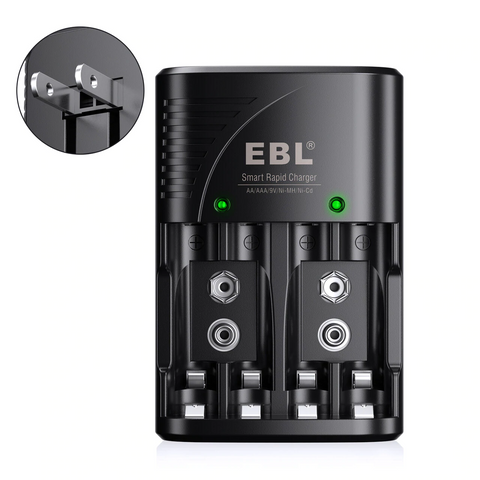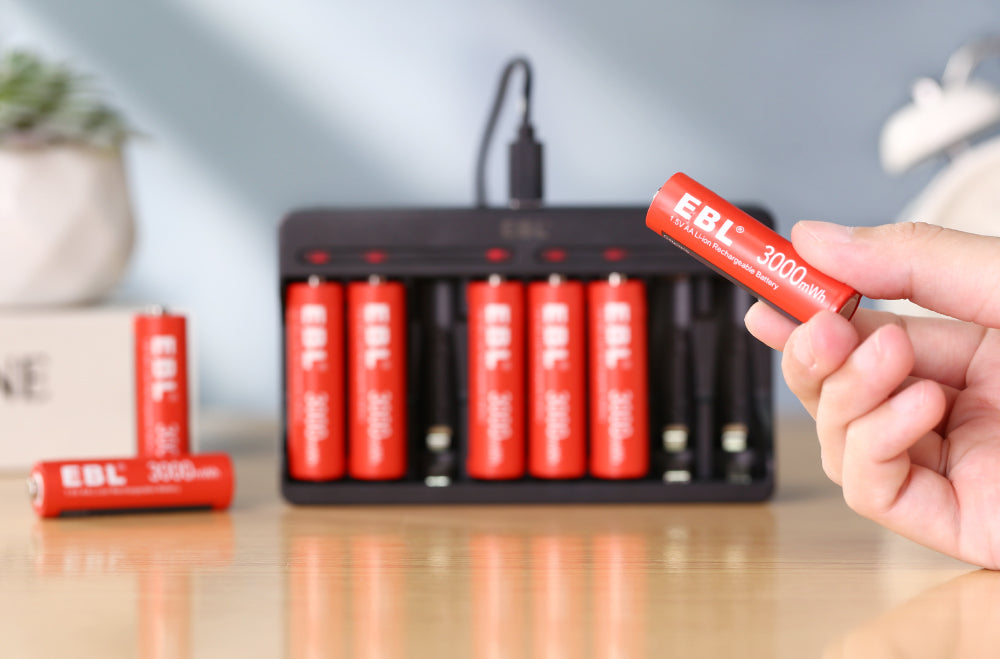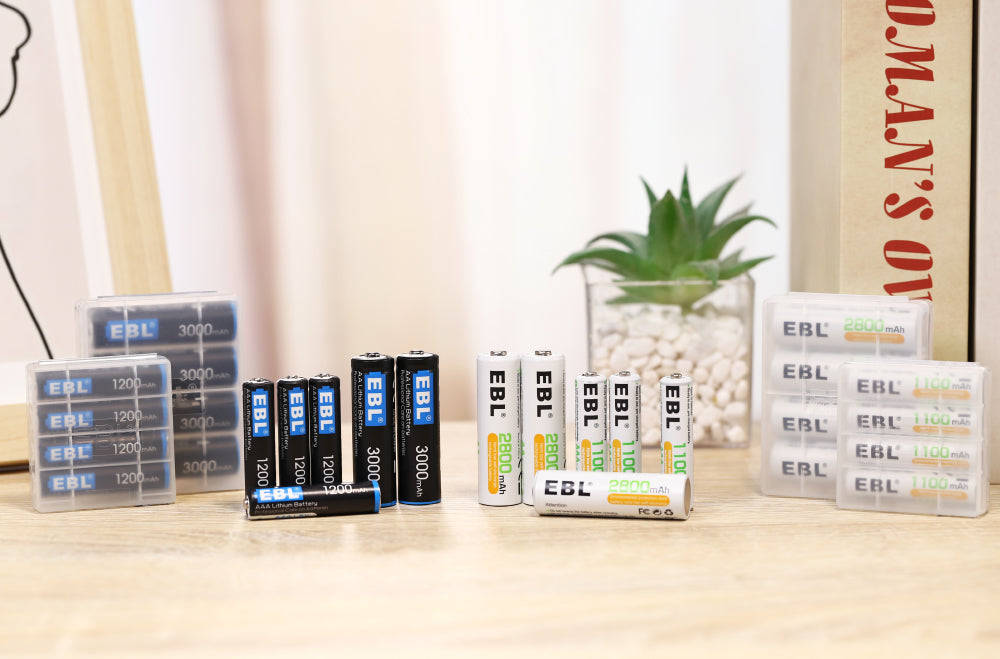
The life of a Nickel-Metal Hydride (NiMH) battery can significantly be influenced by usage conditions. Equally important is the choice of a charger that can ensure optimal performance and longevity. A smart charger that can effectively control overcharge, current fluctuations, and overheating, among other functionalities is one of the ways to longer battery life.
Also, certain factors (such as storage without use or charge for a long period) can make a good NiMH battery seem lifeless. The simple trick proposed in this article will show you how to bring back a 0V/low voltage NiMH battery to life in addition to recommending the best charger for your NiMH batteries.
What is a NiMH battery?
A NiMH battery is a rechargeable type of battery that stores energy via electrochemical charge/discharge reactions that take place between a positive electrode or cathode that has nickel oxide-hydroxide (Ni(OH)2) as its active material and a negative electrode or anode made up of a hydrogen-absorbing alloy (MH).
Both the cathode and anode are separated by a permeable membrane which enables electrons and ions to pass through them and which is immersed in an aqueous potassium hydroxide (KOH) electrolyte that is resistant to any major changes when in use.
In terms of electrochemistry, the NiMH battery is similar to the Ni-CD battery (both have a cathode that contains nickel oxide-hydroxide). The main difference between them is in their anodes (Ni-CD has an anode made up of cadmium rather than the hydrogen-absorbing alloy found in the NiMH anode). Both battery types have a voltage of 1.2V.
The electrochemical reactions that take place in a NiMH battery are:
Anode (−) M + e− + H2O → MH+OH−
Cathode (+) Ni(OH)2 + OH− → NiO(OH) + H2O+e−
Overall reaction M + Ni(OH)2→MH + NiO(OH)
Where ‘M’ is an intermetallic alloy that can form a metal hydride phase.
The main components of a NiMH battery

Factors that can Affect NiMH Battery Life
Here are a few things to consider if you want to prolong the life of your NiMH batteries:
Extent of Overcharge
The extent of overcharge the battery is subjected to should be determined by usage demands, e.g., those who usually need their NiMH battery operating at full capacity. In such cases, it can be essential to overcharge your NiMH battery sometimes to ensure they are fully charged and operate optimally. However, this should not be regular practice because frequent overcharging can reduce battery life.
Use in High-Temperature Conditions
Charging at higher temperatures (above 40°C) can reduce charge acceptance as well as make it harder to sense the transition from charge to overcharge. Higher temperatures also quicken the rate of chemical reactions in the battery, including reactions that facilitate aging.
Reversal
If you want your NiMH batteries to last longer, then do not discharge them to such an extent that some or all of them go into reverse since this can reduce their lifespan, especially if the over-discharge is done frequently.
Extended Storage under Load
Keeping a load on a battery beyond full discharge can lead to permanent undesirable life-reducing changes in the battery chemistry such as creep leakage.
Dendrite formation
Like in Ni-CD and other batteries, NiMH batteries may sometimes seem lifeless if a short emerges between their positive and negative terminals. The short is brought about by a metallic dendrite crystal due to the electric charge between the two terminals which creates the environment for dendrite formation.
0V/Low Voltage NiMH Battery Revival Tips
You need the following items to bring a 0V/low voltage NiMH battery back to life:
- A voltmeter
- The temporarily lifeless battery you want to bring back to life
- Another battery of the same size and voltage that has life and is fully charged
- Two electricity-conducting cables with naked ends (or a couple of any other electrical conductors, e.g., long metal bars)
- A smart battery charger – the EBL Smart Battery Charger for C, D, AA, AAA 9V Ni-MH, and Ni-CD rechargeable batteries is highly recommended
The first step in reviving a 0V/low voltage battery is to use the voltmeter to verify the amount of voltage in the lifeless battery. If the battery indeed has 0V, you will see this indicated on the voltmeter. The 0V battery will also not charge when inserted into the smart charger.
When you have determined that the battery has no life (or little life), it is now time to bring it back to life. The process is simple. All you have to do is use one of the naked cables to connect the positive terminal of the fully charged battery to the positive terminal of the lifeless battery and then use the second cable to connect both negative terminals as well. Keep the two batteries connected for three seconds and then disconnect.
After disconnecting, use the voltmeter again to see the effect of connecting the fully charged battery to the 0V battery. You’ll notice that the previously 0V battery now has some voltage in it. Next, insert the 0V charger back into the smart charger and you’ll notice that it is now charging, unlike before. That is it, your 0V battery is now back to life. Congratulations! Allow the battery to charge to full capacity and then start using it on your devices.
How to recover rechargeable batteries that wont charge in a smart charger
This problem is often caused by the formation of dendrites and subsequent shorting of the battery (as mentioned above). Thus, connecting a fully charged battery to the temporarily lifeless or shorted battery makes a very high current pass through the dendrite that makes it hot and then melt to break the short and bring life back to the battery.
Charged NiMH rechargeable batteries have a very short shelf life. Most NiMH batteries lose about 1% of their charge per day just sitting idle. Many people have learned this the hard way. They put some fully charged batteries in a device and use it for a short while and put it away. A month or two later they return to that device only to find a low or dead battery. Keep your rechargeable batteries topped off by placing them on a charger once a month if they aren't being used.
When batteries are new, realize that it may take a few charge/discharge cycles before they begin operating at their stated capacity. Note that NiMH batteries are more sensitive to charging conditions than Ni-CD batteries. For instance, undercharging can make them work sub-optimally while overcharging can lead to overheating, damage to the cell, and loss of cycle life.
Therefore, it is important to take proper care to guard against these and even more important to choose a battery that has been efficiently designed for the NiMH battery system. This is why the EBL 906 Smart Battery Charger mentioned above should be your choice if you want peace of mind when it comes to charging your C, D, AA, AAA 9V Ni-MH, and Ni-CD rechargeable batteries without any problems.
The EBL 906 Smart Charger is MCU controlled, adopts the -∆V intellectual cut-off charging method, automatically turns to trickle charge, and prevents the batteries from over-voltage, over-current, or over-heat. It will automatically stop charging when it detects improper input voltage, inefficient or short circuit, or non-rechargeable batteries. This high-quality charger is designed with a constant current charging mode that protects the batteries against current fluctuation and ensures you use the charger safely.
EBL 906 Smart Charger
In a nutshell, the 2 channel mechanism that the EBL 906 Charger uses to activate 0V/low voltage batteries are as follows:
- aa/aaa channel: battery more than 0.22V can be revived. For aa/aaa battery.
- 9V channel: 0V can be activated-- for a 9V battery, take a look at this charger: https://www.eblofficial.com/products/smart-battery-charger2605
EBL 802 Smart Charger
EBL 802 Smart Charger can refresh battery: if the voltage of battery is too low(nearly 0V~0.9V), the charger can refresh battery itself.
What of reviving a 9V lithium battery with a protection plate and no voltage?
Reviving a 9V battery with the above characteristics can be approached from two perspectives:
- The battery is protected: Use a professional charger such as the EBL 906 Smart Charger to revive it.
- The battery is over-discharged: In this case, the 9V lithium battery cell has been pulled to 0V and cannot be charged and activated on a professional charger. One probable solution involves disassembling the 9V lithium battery and bypassing the protection plate directly connected to the positive and negative electrodes of the battery cell. However, a 9V lithium battery activated in this way will not last long and more importantly, may have safety risks. Therefore, this method is not recommended.
So your best option is a professional charger like the very affordable EBL 906. You can find more information on our website.
Related Blogs:
- Why Do Fully Charged Batteries Die Quickly? Reason And Solution.
- How to store battery correctly?
- Best Batteries For Toys And Guidelines For Choosing Them







1 comment
Angelo Granata
Buongiorno…ho acquistato le vostre batterie ebl ministilo serie oro da 1100 mah.. Ho notato che sul loro corpo non è presente ne il tempo di carica ne la corrente di carica esempio..14 h a 100 ma.. Vorrei poi sapere se le posso caricare con un caricabatterie x batterie ni-mh gia in mio possesso oppure bisogna utilizzare il vostro..il quale magari dispone di una curva di carica particolare..ed in ultimo la tensione di queste pile è di 1.2 v come le altre ni-mh o è differente ..attendo vostre notizie ..saluti angelo ..3393175726..grazie
Leave a comment
All comments are moderated before being published.
This site is protected by hCaptcha and the hCaptcha Privacy Policy and Terms of Service apply.